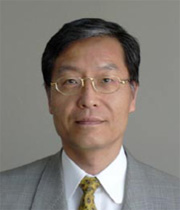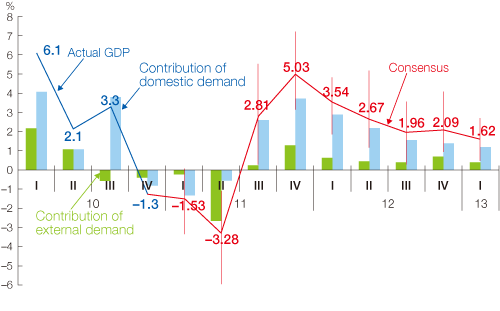Home > Highlighting JAPAN > Highlighting Japan MAY 2011 > Coherent Policy Management the Key
Highlighting JAPAN
COVER STORY: The Road to Recovery
Coherent Policy Management the Key
What course is the Japanese economy likely to take in the aftermath of the Great East Japan Earthquake? Professor Takao Komine of the Hosei Graduate School of Regional Policy Design comments.

Professor Takao Komine
First, in Phase 1, stock is destroyed. According to the Cabinet Office estimate, the amount of stock destroyed by this earthquake is 16 to 25 trillion yen.
The economic impact of the flow is also a great blow. According to the economic forecast survey of top economists in Japan, the ESP Forecast Survey for May, 2011, the GDP growth rate (real GDP, annual rate compared to the previous quarter) for the January to March 2011 quarter is predicted to be -1.5%, and -3.3% for the April to June quarter.*
Why will growth slump this much? The severing of the supply chain network has a big influence on this. Mechanical devices such as cars and electronic goods are assembled from numerous parts. The supply chain network is the distribution method for supplying these parts to the manufacturing plants. The Tohoku region, which was hit by this disaster, has a concentration of car and electronic goods parts manufacturers. Because of the earthquake, the supply of these parts was impeded, and caused a drastic reduction in manufacturing in areas outside the disaster area as well.
However, when we arrive at Phase 2, the growth rate is instead predicted to climb. According to the aforementioned ESP Forecast Survey, the growth rate is predicted to turn positive from the July to September quarter onward, and achieve a truly high growth rate of 5.0% in the October to December quarter.
There are two reasons why such a high rate of growth is predicted. First is the demand from reconstruction. As repair work gets into full swing, there will be an increase in residential investment to recover the destroyed housing stock, private non-residential investment to rebuild factories and office buildings, and public investment to restore the function, such as roads, harbors and railways.
The other reason is the prospect for the flow. Its range of reduction will be smaller. After the initial slump in flow, it gradually returns to normal. Manufacturing will revive, and the supply chain will gradually be rebuilt.

Estimated Growth Rate of GDP
Source: Economic Planning Association, "ESP Forecast" May 2011
Prioritizing Objectives
In this way a high growth in the economy can be expected in Phase 2, however there will be a difficult problem in managing the economy. During the emergency in Phase 1, the policy objectives are very clear: saving lives and assisting survivors are more important than anything else. There's no need to worry about trade-offs with other policy objectives. However, in Phase 2, policy objectives must be prioritized, considering trade-offs. There becomes a demand for a policy that is both coherent and economically rational. Particularly difficult problems are the following points to consider.
The first problem is finances. The government has already decided on a supplementary budget worth about 4 trillion yen, and there will certainly be a need for even greater expenditures in the future. Considering the extremely poor financial situation the government is in due to the tremendous budget deficit Japan is already burdened by, it avoids as much as possible issuing any more government bonds, so producing a tremendous amount of funds by cutting other budgets becomes a huge problem.
The second problem is revival of the affected region. In the three prefectures of Tohoku, Iwate, Miyagi and Fukushima Prefecture, that were hit by the disaster, the population was aging very rapidly and residents had been moving away. These areas are also heavily dependent on farming and fishing, so they have difficulty securing a workforce. In such difficult circumstances, it will be necessary to create a structure assembling outside corporations and people into the region, to provide highly preferential treatment.
The third problem is a reexamination of the energy policy. Because of the accident at the nuclear power plant that was triggered by the earthquake, there is expected to be an extreme shortage of electricity throughout the Kanto region this summer. Of great concern is how energy will be supplied in the long term, especially whether we should continue to be dependent on nuclear energy as a power resource, as well as what position renewable energies such as wind or solar power will take.
The steering of policy management during Phase 2 will determine the future course of the Japanese economy and society.
*Note: After the survey, the GDP growth rate of -3.7% for the January to March quarter was announced.
© 2009 Cabinet Office, Government of Japan






